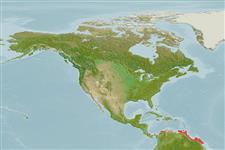Actinopterygii (ray-finned fishes) >
Perciformes (Perch-likes) >
Sciaenidae (Drums or croakers)
Etymology: Cynoscion: Greek, kyon = dog + Greek, odous = teeth + Greek, skion, skiaina = barbel, red mullet (Ref. 45335). More on author: Randall.
Environment / Climate / Range
Ecology
Marine; demersal; depth range 20 - 60 m (Ref. 3702). Tropical, preferred ?; 12°N - 4°N
Western Atlantic: Colombia to northern Brazil. Also reported in Nicaragua (Ref. 13613).
Size / Weight / Age
Maturity: Lm ? range ? - ? cm
Max length : 60.0 cm TL male/unsexed; (Ref. 3702); common length : 40.0 cm TL male/unsexed; (Ref. 3702); max. published weight: 2.0 kg (Ref. 5217)
Dorsal
spines
(total): 11;
Dorsal
soft rays
(total): 24-29;
Anal
spines: 2;
Anal
soft rays: 8 - 10. Silvery grey on back, pale below. Trunk with dotted oblique stripes along scale rows. Inside opercle black, visible externally. Spinous dorsal-fin margin dark. Mouth large, slightly oblique, lower jaw projecting. Upper jaw with a pair of large canine-like teeth at tip. Chin without barbels or pores. Snout with 2 marginal pores. Gas bladder with a pair of straight, horn-like anterior appendages. Soft dorsal fin unscaled except 2 or 3 rows of small scales along its base (Ref 51721).
Found over mud and sand bottoms (Ref. 3702). Marketed mostly fresh (Ref. 3702).
Life cycle and mating behavior
Maturity | Reproduction | Spawning | Eggs | Fecundity | Larvae
Cervigón, F., 1993. Los peces marinos de Venezuela. Volume 2. Fundación Científica Los Roques, Caracas,Venezuela. 497 p. (Ref. 9626)
IUCN Red List Status (Ref. 115185)
CITES (Ref. 94142)
Not Evaluated
Threat to humans
Harmless
Human uses
Fisheries: minor commercial
More information
Common namesSynonymsMetabolismPredatorsEcotoxicologyReproductionMaturitySpawningFecundityEggsEgg development
ReferencesAquacultureAquaculture profileStrainsGeneticsAllele frequenciesHeritabilityDiseasesProcessingMass conversion
Tools
Special reports
Download XML
Internet sources
Estimates of some properties based on models
Phylogenetic diversity index (Ref.
82805): PD
50 = 0.5000 [Uniqueness, from 0.5 = low to 2.0 = high].
Bayesian length-weight: a=0.00832 (0.00408 - 0.01697), b=3.08 (2.91 - 3.25), in cm Total Length, based on LWR estimates for this Genus-body shape (Ref.
93245).
Trophic Level (Ref.
69278): 3.9 ±0.7 se; Based on size and trophs of closest relatives
Resilience (Ref.
69278): Medium, minimum population doubling time 1.4 - 4.4 years (Preliminary K or Fecundity.).
Vulnerability (Ref.
59153): Moderate vulnerability (36 of 100) .
